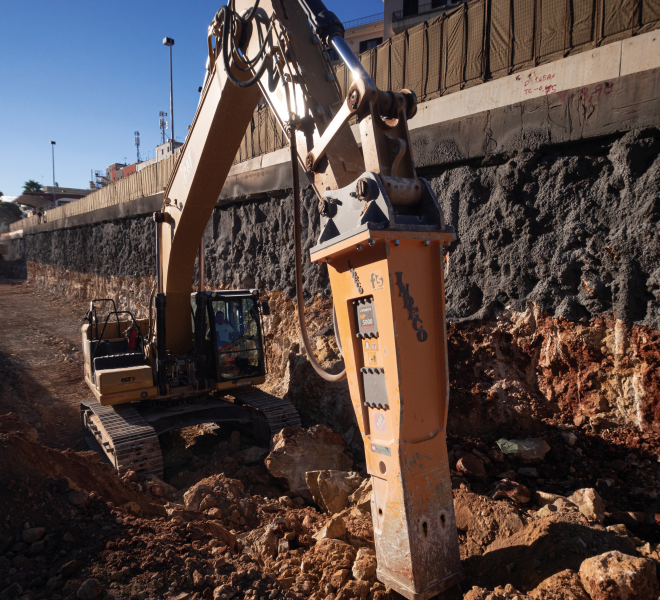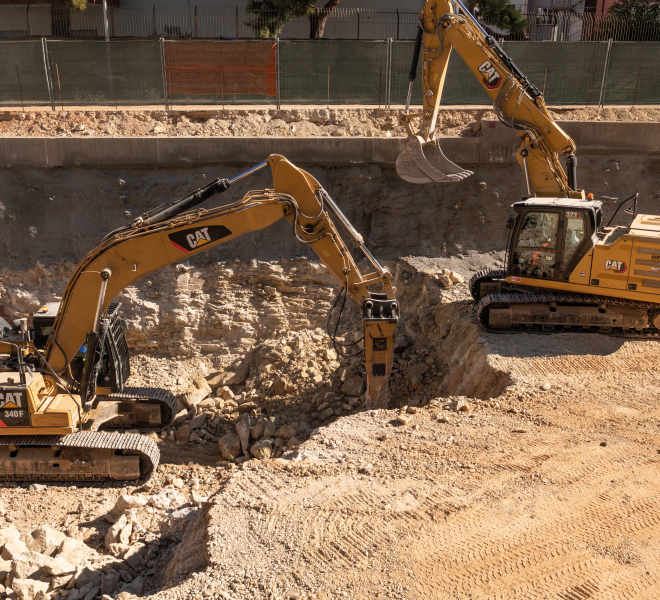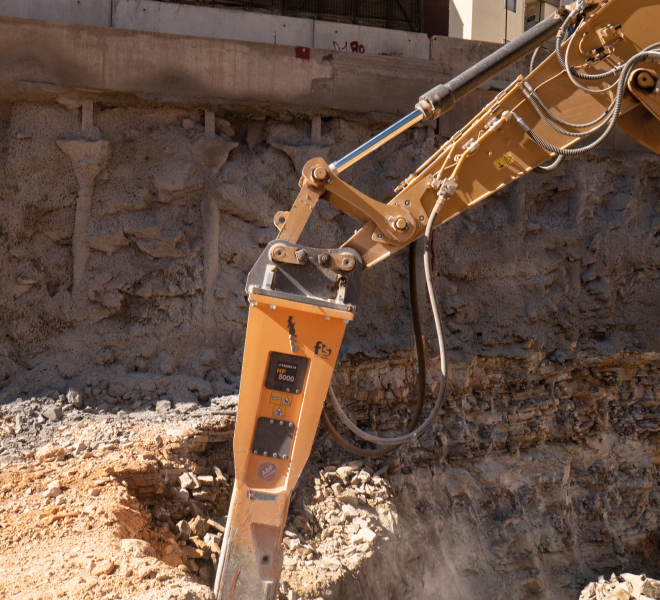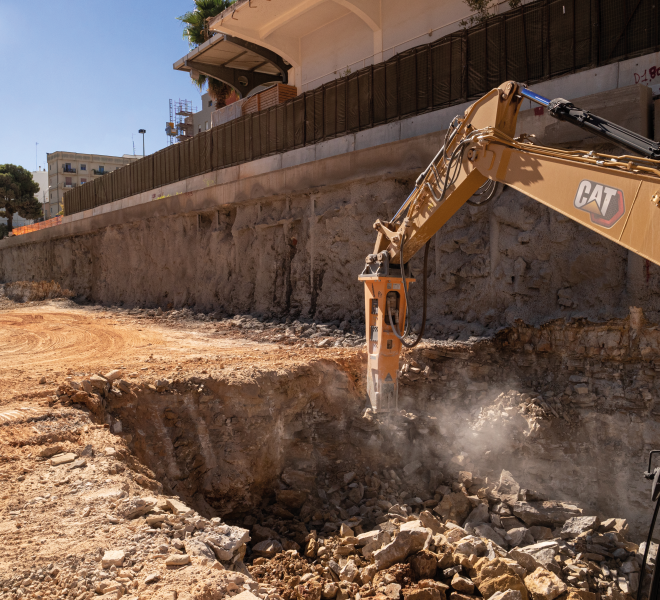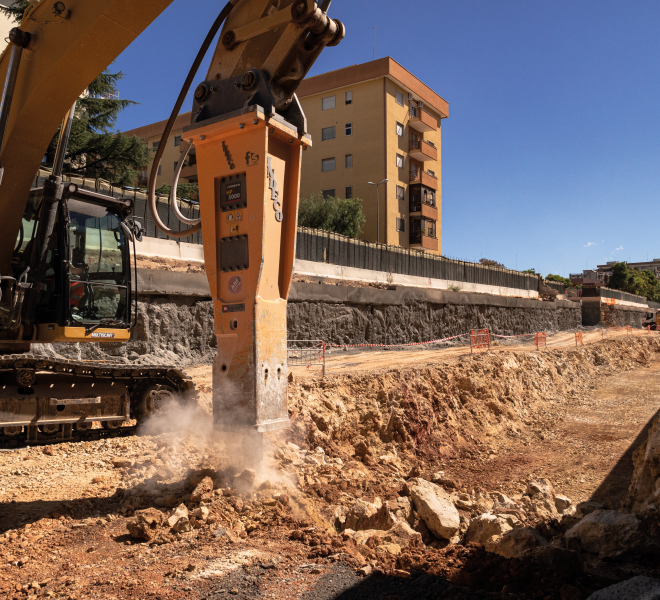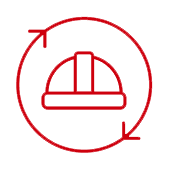Indeco takes on a big dig
Благодаря HP 9000, двум HP 7000 и подключившемуся к ним на финишной прямой «главному калибру» HP 18000 удалось выполнить этот масштабный проект вовремя.
Lowering the tracks that cross the city of Andria is an important step in the renewal of railway transport in the northern region of Puglia in Southern Italy. The project, commissioned by Ferrotramviaria S.p.A. – the company that oversees 70+ km of the railway line of the Ferrovie del Nord Barese – is part of the more ambitious project to upgrade rail links in the metropolitan area of Barletta, Andria and Trani (BAT province) that serves about 700,000 inhabitants. When finished, the infrastructure is destined to improve mobility within the province since it will facilitate and speed up the public transport system. The infrastructure upgrade will also have repercussions on the urban fabric of Andria, which will see areas previously occupied by the railway line and its related structures become accessible, making them available for new functions, such as green areas, bike lanes and new public spaces, etc. The project entails the excavation of a trench under the old line of the single-track railway from the progressive 56+255.58 km to the progressive 59+188,39 km, a total length of 2,932.81 m. It also provides for concrete box structures at the level crossings to allow for the passage of traffic, the construction of water collection tanks, the building of a new station (Andria Nord) and the renovation of the existing Andria Central Railway Station. In May 2018 Ferrotramviaria Spa awarded the project to Consorzio Integra, winner of the integrated contract including the «executive project and completion of the works. Integra, an important cooperative that gathers construction, engineering and service companies, assigned the project to its member, CMB.
Hard, slightly fractured rock
In geological terms, Andria is characterised by dark grey dolomite and grey dolomitic limestone interspersed with fine-grained micritic or bioclastic white limestone. The dark grey dolomite and grey limestone appear in laminated layers or banks and show extensive weathering. The rock formations are often separated from the so-called red soils, that is, residual terrain with a largely silt grain size, at times accompanied by chalky gravel. As per project specifications the trench must have a depth of -5 to -11 m from the surface level; but at the level of the water collection tanks the depth reaches over -16 m. Arriving at the bottom of the trench means crossing rocky layers with a high hardness and density due to a relatively low degree of fracturing (average 50-75% on the RQD index). In some areas, the grey dolomite is presented as large erratic rocks with high density and hardness that can even exceed a compressive strength of 150 MPa. Given the geological setting, the excavation used to dig the nearly 3 km is crucially important for works with a 560-day completion time. Due to the site’s geological characteristics, engineers needed a retaining wall to be built for consolidation before the start of excavation. Also, the presence of nearby roads, and in some points buildings close to the track, called for a solution to counteract the thrusts on the trench walls. The system consists of micropiles, 190 mm or 220 mm in diameter, reinforced with HEB beams, and in some points with a row of passive soil nails. In the work sequence excavation is performed as the retaining system advances, with the wall progressively sprayed with fibre-reinforced shotcrete; finally, the excavated trench will be cast with the definitive lining. Since blasting was impracticable due to the urban setting, CMB initially considered using milling machines and roadheaders. In principle, these machines had the dual advantage of creating limited vibrations and ensuring a production of waste material that would avoid secondary crushing for loading and transport. However, given the prevalence of red soils and the uneven stratification of the rock at the base of the trench, the site technical management eliminated this option as well; the teeth would have lost the capacity to mechanically break the material, causing it to be pressed into the drum of the milling machine, and thereby impact the operation of the excavation system and reduce productivity. At that point, the decision was made to use hydraulic hammers, provided they be high-powered enough and in the suitable number to meet the site requirements and allow a production in line with project scheduling.
Calling in the professionals
The size of the excavation – involving the removal of over 250,000 cu m of material – and the hardness of the rock called for a subcontractor with the experience and equipment to manage the works and related logistics. After a careful selection, CMB chose Multiscavi srl based in Andria, whose fleet of over 100 machines, and especially with a solid experience in excavations, backfilling and demolitions, offered the best guarantees for performing the project and organising loading and transport of the vast amount of material to the landfill. The time frame for the works, the excavation being a major phase, would not allow for delays that would impact the start of other phases and thus the delivery of the whole project. Sebastiano Liso, manager of the company along with his brother Vincenzo, had this to say: «A trench of these proportions, and the time allowed for excavation, implies a very precise technical and economic evaluation. This also goes for a company like ours that has a lot of experience in the field and a fleet of equipment of a size and technological capacity up to the task.
Actually, there are several challenges to meet on this job site, starting with the hardness of the rock, which isn’t the only aspect that we evaluated carefully; organisation and logistics have a big role in this project too. Bear in mind that we’re working in a trench that expands to 19 m only at the Andria Central Railway Station, but for most of the section it’s only 7.5 m wide. So we need to accurately determine the positioning of the machines and the mobility at the site to avoid slowing down operations and creating safety risks. The excavation also depends on the completion of the consolidations performed first, so a degree of flexibility in weekly job scheduling is needed.»
Indeco delivers reliability and productivity
The rocks along the section have a strength of 35-150 MPa, so they are a true test of the hammers’ power and performance. The sheer size of the excavation and the continuous operation of the Indeco attachments over a period of months only intensify the application, which is actually more similar to a quarrying job than an infrastructure project. Productivity and reliability are obviously key factors in a situation that, unlike a quarry cycle, also requires strict adherence to a schedule that is tied to the progress of the job site as a whole.
As Sebastiano Liso said: «We’ve been using Indeco hammers for a few years now, and after trying out other manufacturers’ attachments, we now count an HP 7000, two HP 5000, an HP 3500 and an HP 3000 in our fleet.
At the Andria site, we’re using an HP 7000 coupled to a CAT 340 excavator and two HP 5000 coupled to CAT 330 excavators. This application immediately presented a challenge to prove the reliability of both the machines and attachments; the hammers, especially, were constantly submitted to stress. It’s hard rock along the entire section, but what’s really tough is the dolomite, or pietra nera as we call it here. In some areas we come across huge, very dense erratic rocks that put the hammers to a hard test. But this is the difference between Indeco and other hydraulic hammers; when well matched to the machine and used by expert operators like ours, these attachments yield excellent results despite the tough application. All the hammers’ components come under stress, especially considering that these attachments have already racked up hundreds of hours of excavation and have to operate for several months before completing the project. When it comes down to it, reliability is an even more decisive factor on this job site; if it doesn’t satisfy the productivity requirements, it could even turn our margin into a loss. From this standpoint, Indeco is a real insurance policy». The productivity demanded on the Andria site is also guaranteed by Indeco’s solutions for all hammers of its range: in fact, the HP 7000 and the two HP 5000 used for excavating the trench feature a special hydraulic system that automatically varies energy and blows according to rock hardness. The hydraulic power delivered by the excavator is thus optimised all to the advantage of productivity and overall output which is distinctly higher. The dual damping system instead helps to minimise stresses to the boom and subject it to the least amount of vibrations possible; an advantage also achieved by the optimum ratio between weight and power.

